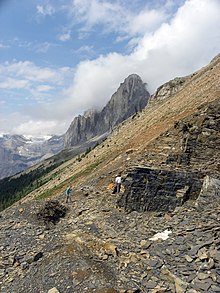Stephen formation
| Stephen Formation Stratigraphic range: Middle Cambrian |
|
|---|---|

|
|
| Type | Geological formation |
| Underlies | Eldon Formation |
| Overlies | Cathedral Formation |
| Thickness |
"thin", < 60 metres (200 ft) "thick": up to 335 metres (1,100 ft) |
| Lithology | |
| Primary | Shale, limestone |
| Other | Siltstone |
| Location | |
| Coordinates | 51°27′51″N 116°19′28″W / 51.46425°N 116.32443°WCoordinates: 51°27′51″N 116°19′28″W / 51.46425°N 116.32443°W |
| Region | WCSB |
| Country |
|
| Type section | |
| Named for | Mount Stephen (from George Stephen) |
| Named by | C.D. Walcott, 1908 |
"thin", < 60 metres (200 ft)
The Stephen Formation is a middle Cambrian unit exposed in the Canadian Rockies of British Columbia. It is famous for the exceptional preservation of soft-bodied fossils: the Burgess Shale biota. The formation overlies the Cathedral escarpment, a submarine cliff; consequently it is divided into two quite separate parts, the 'thin' sequence deposited in the shallower waters atop the escarpment, and the 'thick' sequence deposited in the deeper waters beyond the cliff. Because the 'thick' Stephen Formation represents a distinct lithofacies, some authors suggest it warrants its own name, and dub it the Burgess Shale Formation. The stratigraphy of the Thin Stephen Formation has not been subject to extensive study, so except where explicitly mentioned this article applies mainly to the Thick Stephen Formation.
The Stephen Formation formed at a low-latitude miogeoclinic continental margin, at the western limit of a continental craton. Detrital sediments were washed in by rivers from the continent, over the limestone reefs which formed the shallow sea floor. At the top of sequence-stratigraphic cycles, oncoids were sometimes washed in to the Thin Stephen formation from the shallower waters closer to the shore.
The fossiliferous deposits of the Stephen Formation are a collection of slightly calcareous dark mudstones, about 508 million years old. The beds were deposited on top of and at the base of a cliff about 160 meters (520 ft) tall, below the depth agitated by waves during storms, and thus at a water depth of around 200 m. This vertical cliff was composed of the calcareous reefs of the Cathedral Formation, which probably formed shortly before the deposition of the Burgess shale. The precise formation mechanism is not known for certain, but the most widely accepted hypothesis suggests that the edge of the Cathedral formation reef became detached from the rest of the reef, slumping and being transported some distance — perhaps kilometres — away from the reef edge. Later reactivation of faults at the base of the formation led to its disintegration from about 509 million years ago. This would have left a steep cliff, the bottom of which would be protected, because the limestone of the Cathedral formation is difficult to compress, from tectonic decompression. This protection explains why fossils preserved further from the Cathedral formation are impossible to work with — tectonic squeezing of the beds has produced a vertical cleavage that fractures the rocks, so they split perpendicular to the fossils. The Walcott quarry produced such spectacular fossils because it was so close the Stephen formation — indeed the quarry has now been excavated to the very edge of the Cambrian cliff. Both the thick and thin Stephen formation were deposited below wave base.
...
Wikipedia
